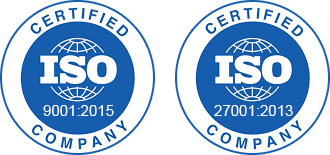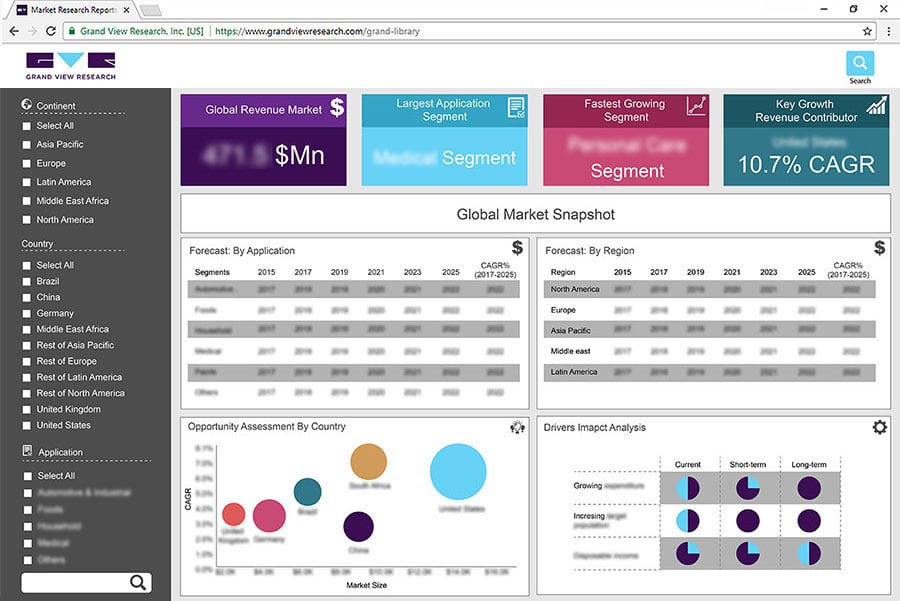- Home
- »
- Medical Devices
- »
-
Cryoablation Devices Market Size & Share Report, 2030GVR Report cover
![Cryoablation Devices Market Size, Share & Trends Report]()
Cryoablation Devices Market Size, Share & Trends Analysis Report By Product (Tissue Contact Probe Ablators, Tissue Spray Probe Ablators), By Application (Lung Cancer), By End-use, By Region, And Segment Forecasts, 2023 - 2030
- Report ID: GVR-4-68040-040-4
- Number of Report Pages: 110
- Format: PDF, Horizon Databook
- Historical Range: 2018 - 2021
- Forecast Period: 2023 - 2030
- Industry: Healthcare
Report Overview
The global cryoablation devices market accounted for USD 374.03 million in 2022 and is expected to expand at a CAGR of 13.70% from 2023 to 2030. The rising prevalence of cancer and the high demand for safer therapeutic options are the major factors contributing to the growth of the cryoablation devices market. In addition, a rising preference for minimally invasive surgeries is anticipated to propel the demand for cryoablation devices across the globe.
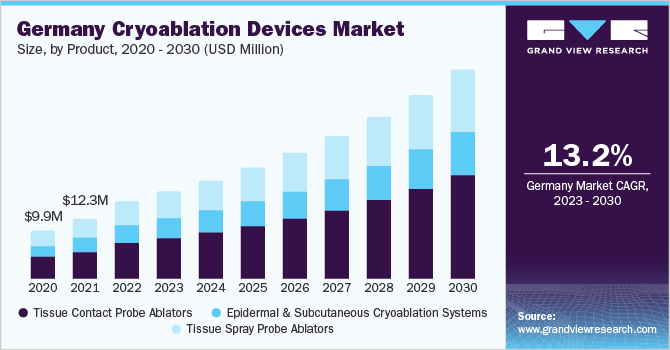
Increasing inclination of the patients and surgeons towards non-invasion or minimal invasion treatment procedures due to the advantages such as patient comfort, speedy recovery, and minimized turnaround time are a few of the factors which are anticipated to fuel demand for cryoablation devices during the forecast period. Advanced cancer ablation procedures are mostly performed on an outpatient basis and do not require any hospital admission as compared to conventional therapies, resulting in a significant reduction in total healthcare expenses. Ablation therapy is the preferred surgery for cancer of small sizes. Hence, the procedural volume is indirectly reliant on the yearly tumor screening tests.
According to the CDC in October 2022, approximately 12 million U.S. individuals suffered from atrial fibrillation by 2030. Moreover, in 2019, around 183,321 deaths were caused in the U.S. Furthermore, approximately 450,000 hospitalizations were recorded with atrial fibrillation as the key diagnosis every year in the U.S. The rising prevalence of atrial fibrillation is predicted to enhance demand for the cryoablation devices market during the forecast period.
A rise in the prevalence of tumors such as lung cancer, prostate cancer, breast cancer, and many more in several countries across the globe is anticipated to fuel the cryoablation devices market growth. As per an article published by CDC in June 2022, nearly 221,097 new lung cancer cases were reported in the U.S., and 139,601 deaths were caused due to lung cancer. Furthermore, every year, in the U.S., approximately 25,000 men and 11,000 women get liver cancer, and around 9,000 women and 19,000 men die due to the same.
According to the survey, conducted by NCI's Surveillance, Epidemiology, and End Results (SEER) Program, conducted in March 2021, the most common age for getting a tumor diagnosis is 66 years, that is, half of the tumor cases occur in individuals under this age. The geriatric population is held as the main target population for minimally invasive or noninvasive cryoablation techniques, due to the compromised body’s biological functions. Thus, the rising geriatric population base is expected to augment demand for cryoablation devices during the forecast period.
Product Insights
The tissue contact probe ablators segment dominated the market with a market share of 44.41% in 2022 and is anticipated to have the fastest CAGR during the forecast period. It is due to the developing healthcare infrastructure, adoption of changing trends in the healthcare system, and consumption patterns. The increasing focus of manufacturers in developing advanced cryoablation devices is expected to contribute towards market growth.
The ablation probe makes contact with the target which is tumor cells and uses freezing technology to destroy the abnormal tissues. For instance, cryoFORM Cryoablation Probe, a product of AtriCure, is one of the latest generations, which features a thermal capacity to remove heat and increase the flexibility for various ablation treatments.
The use of the product insures minimal invasive during ablation surgeries owing to faster recovery. Moreover, increasing investments by the key players, rapid industrialization, and increasing technological advancements are also anticipated to boost the market growth of cryoablation devices. The recent advancements in probe nanotechnologies assist healthcare professionals to detect and treat cancer. Nanoprobe biotechnology thus helps in, discovering new cancer biomarkers which become a key part of an early cancer diagnosis.
Tissue spray probe ablators held a considerable revenue share in 2022. Increasing preference and demand for tissue spray probes owing to their increasing advantages are anticipated to foster segment growth. The rising focus of manufacturers on developing advanced tissue probe ablators is estimated to contribute toward segment progression.
Application Insights
The cardiac arrhythmia segment dominated the market with a share of 37.37% in 2022 owing to the rising cardiovascular disorders that are anticipated to increase the risk of developing heart damage such as abnormal heart valves, cardiomyopathy, narrowed heart arteries, and many more. According to the WHO, in 2021, 17.9 million deaths occurred due to CVD every year worldwide. Moreover, it is anticipated that more than 3.6 million people will die from CVD, mainly from heart disease and stroke by 2030. The prevalence of getting cardiac arrhythmia is estimated to be between 1.5% to 5.0% in general. Thus, the increasing prevalence of cardiovascular disorders globally is expected to strengthen segment growth.
The breast cancer segment is estimated to expand at the highest CAGR through the forecast period. According to the American Cancer Society article, published in January 2023, nearly 297,790 and 55,720 novel breast cancer cases and ductal carcinoma in situ (DCIS) respectively will be reported this year. Approximately 43,000 women death cases due to breast cancer will be reported in the year 2023.
Furthermore, the median age estimated by the American Cancer Society is 62 years at which most women get breast cancer diagnosed. Although, breast cancer is mostly diagnosed in women, however, men get diagnosed too with breast cancer. According to a CDC article, published in September 2022, every 1 man out of 100 gets diagnosed with breast cancer. Moreover, according to the American Cancer Society, in 2023, around 2,800 novel breast cancer cases will be diagnosed in men, and in that 530 men are expected to die from cancer. The growing cases of individuals diagnosed with breast cancer are anticipated to propel the growth of the market for cryoablation devices.
End-use Insights
In 2022, the hospital segment dominated the cryoablation devices market with the largest share of 54.00%. This is attributed to an increase in the figure of cardiovascular diseases that are enhancing the number of cardiac arrhythmia surgeries which is one of the most common surgeries performed worldwide, and the procedure primarily occurs in hospitals. This type of surgery accounts for more resources used in the cardiovascular domain than any other procedure. In developed countries, insurance companies pay for medical expenditures that include ligature costs. Thus, an increase in the number of cancer cases contributes to the rising demand for cryoablation devices in this segment, which is expected to strengthen growth in future years.
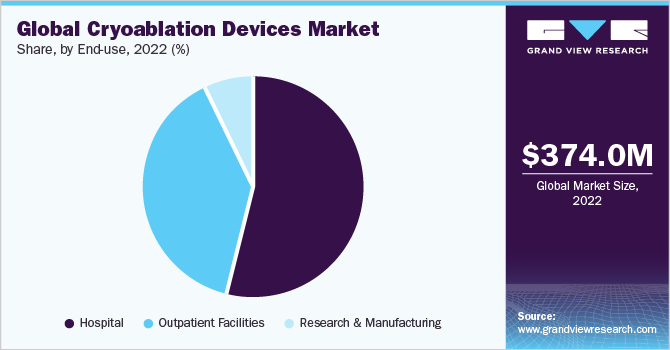
Outpatient facilities have the fasted CAGR growth during the forecast period. According to Definitive Healthcare’s platform, in 2022, there were over 11,815 active ambulatory surgical centers present in the U.S. and the number is most likely to rise in the coming years. This rapid growth trend reflects a rising preference for outpatient procedures. The kinds of procedures performed in ambulatory centers have undergone substantial changes in recent years. Technological advancements in minimally invasive surgeries are contributing to the growing demand for ambulatory surgical centers.
Regional Insights
In 2022, North America dominated the market with a revenue share of 32.56% in terms of revenue owing to the rising prevalence of cancer, better healthcare infrastructure, availability of reimbursement, and growing geriatric population. These factors are driving the cryoablation devices market growth in the region. For instance, the Patient Protection and Affordable Care Act (PPACA), a law passed by the U.S. government, promotes affordability along with the quality of healthcare through various health coverage policies, which helps in reducing the expenses of healthcare for individuals and governments.
Europe holds a considerable revenue share in 2022, owing to the rising public funding in Europe’s healthcare infrastructure. Moreover, the growing geriatric population along with creating awareness by the government organizations to prevent tumors is expected to propel the market growth. For instance, the European Cancer Observatory targets to spread awareness regarding various options to treat a tumor, such as advanced minimal invasion surgeries, and early diagnostic techniques.
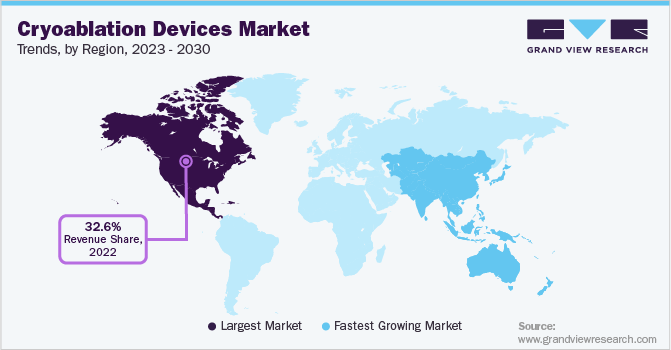
Asia Pacific is anticipated to register the fastest growth rate during the forecast period. The growing presence of many healthcare providers and the rising patient population in developing countries such as India, Thailand, and China are the major factors estimated to foster market growth. Furthermore, with government assistance, the utilization of healthcare infrastructure in the region is expanding. For instance, the Indian government provides financial support for poor individuals suffering from tumors under the Health Minister Cancer Patient Fund (HMCPF) scheme. These government initiatives and other various factors are anticipated to boost the cryoablation device market in the Asia Pacific during the period.
Key Companies & Market Share Insights
Companies are aiming on manufacturing new medical devices, developments, and technological advancements. Moreover, acquisitions and mergers for novel product development and solidification of the supply chain webs constitute some of the considered initiatives implemented by the major players. For instance, in August 2022, Medtronic plc announced the acquisition of Affera, Inc., which is a medical technology manufacturer. This acquisition helped Medtronic in expanding the company’s ablation portfolio by comprising the first cardiac navigation and mapping platform, thus introducing one of the most effective cryoablation technologies in the market. Some of the key players in the global cryoablation devices market include:
-
Boston Scientific Corporation
-
Micro Port Scientific Corporation.
-
Medtronic
-
COOPERSURGICAL, INC.
-
ATRICURE, INC.
-
BVM Medical Limited
-
CPSI Biotech
-
Ice Cure Medical
-
METRUM CRYOFLEX Sp. z o.o.
Cryoablation Devices Market Report Scope
Report Attribute
Details
Market size value in 2023
USD 422.05 million
Revenue forecast in 2030
USD 1,036.66 million
Growth rate
CAGR of 13.70% from 2023 to 2030
Base year for estimation
2022
Historical data
2018 - 2021
Forecast period
2023 - 2030
Quantitative units
Revenue in USD million, CAGR from 2023 to 2030
Report coverage
Revenue forecast, company ranking, competitive landscape, growth factors, trends
Segments covered
Product, application, End-use, region
Regional scope
North America; Europe; Asia Pacific; Latin America; MEA
Country scope
U.S.; Canada; U.K.; Germany; France; Italy; Spain; Denmark; Sweden; Norway; Japan; China; India; Australia; South Korea; Thailand; Brazil; Mexico; Argentina; South Africa; Saudi Arabia; UAE; Kuwait
Key companies profiled
Boston Scientific Corporation; Micro Port Scientific Corporation.; Medtronic; COOPERSURGICAL, INC.; ATRICURE, INC.; BVM Medical Limited; CPSI Biotech; Ice Cure Medical; METRUM CRYOFLEX Sp. z o.o.
Customization scope
Free report customization (equivalent up to 8 analysts’ working days) with purchase. Addition or alteration to country, regional & segment scope
Pricing and purchase options
Avail customized purchase options to meet your exact research needs. Explore purchase options
Global Cryoablation Devices Market Segmentation
This report forecasts revenue growth at global, regional, and country levels in addition to provides an analysis of the latest trends and opportunities in each of the sub-segments from 2018 to 2030. For this study, Grand View Research has segmented the global cryoablation devices market based on the product, application, end-use, and region:
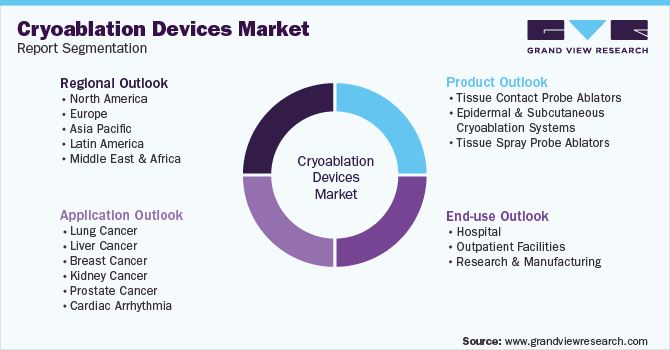
-
Product Outlook (Revenue, USD Million; 2018 - 2030)
-
Tissue Contact Probe Ablators
-
Epidermal and Subcutaneous Cryoablation Systems
-
Tissue Spray Probe Ablators
-
-
Application Outlook (Revenue, USD Million; 2018 - 2030)
-
Lung Cancer
-
Liver Cancer
-
Breast Cancer
-
Kidney Cancer
-
Prostate Cancer
-
Cardiac Arrhythmia
-
-
End-use Outlook (Revenue, USD Million; 2018 - 2030)
-
Hospital
-
Outpatient Facilities
-
Research & Manufacturing
-
-
Regional Outlook (Revenue, USD Million, 2018 - 2030)
-
North America
-
U.S.
-
Canada
-
-
Europe
-
U.K.
-
Germany
-
France
-
Italy
-
Spain
-
Denmark
-
Sweden
-
Norway
-
-
Asia Pacific
-
Japan
-
China
-
India
-
Australia
-
South Korea
-
Thailand
-
-
Latin America
-
Brazil
-
Mexico
-
Argentina
-
-
Middle East & Africa
-
South Africa
-
Saudi Arabia
-
UAE
-
Kuwait
-
-
Frequently Asked Questions About This Report
b. The global cryoablation devices market size was estimated at USD 374.03 million in 2022 and is expected to reach USD 422.05 million in 2023.
b. The global cryoablation devices market is expected to grow at a compound annual growth rate of 13.70% from 2023 to 2030 to reach USD 1036.66 million by 2030.
b. North America dominated the cryoablation devices market with a share of 32.6% in 2022. This is attributable to the increasing prevalence of cancer such as lung and prostrate cancer and cardiac arrhythmia in North America.
b. Some key players operating in the cryoablation devices market include Boston Scientific Corporation, MicroPort Scientific Corporation, Medtronic, COOPERSURGICAL, INC., ATRICURE, INC., BVM Medical Limited, CPSI Biotech, and IceCure Medical.
b. Key factors that are driving the market growth include Increasing preference for minimally invasive surgeries, new product launches, and rising prevalence of cancer.
Share this report with your colleague or friend.
![gvr icn]()
NEED A CUSTOM REPORT?
We can customize every report - free of charge - including purchasing stand-alone sections or country-level reports, as well as offer affordable discounts for start-ups & universities. Contact us now
![Certified Icon]()
We are GDPR and CCPA compliant! Your transaction & personal information is safe and secure. For more details, please read our privacy policy.
We are committed towards customer satisfaction, and quality service.
"The quality of research they have done for us has been excellent."
